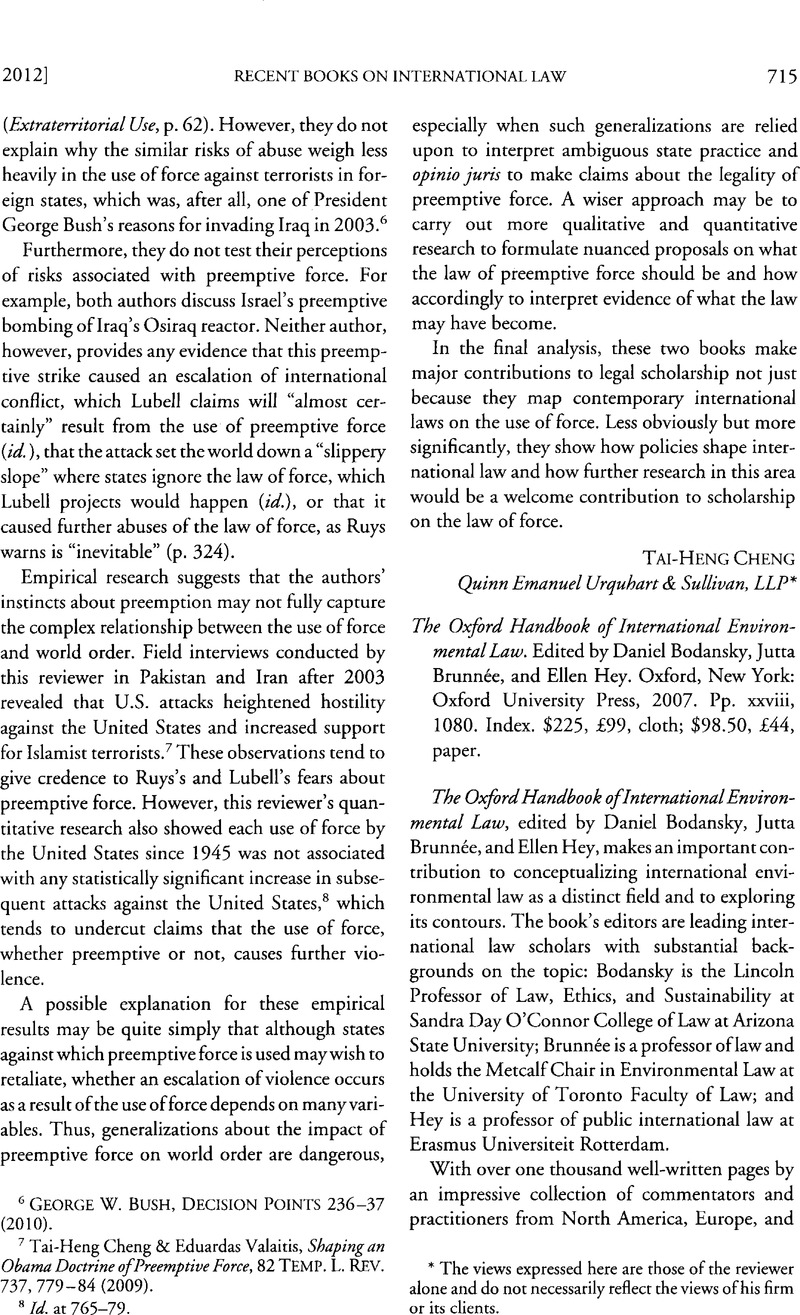No CrossRef data available.
Article contents
The Oxford Handbook of International Environmental Law. Edited by Daniel Bodansky, Jutta Brunnée, and Ellen Hey. Oxford, New York: Oxford University Press, 2007. Pp. xxviii, 1080. Index. $225, £99, cloth; $98.50, £44, paper.
Published online by Cambridge University Press: 20 January 2017
Abstract

- Type
- Recent Books on International Law
- Information
- Copyright
- Copyright © American Society of International Law 2012
References
1 For an example of how cartographic assumptions intersect with law and inequality, see Razack, Sherene H., When Place Becomes Race, in Race, Space, and the Law: Unmapping A White Settler Society l (Razack, Sherene H. ed., 2002)Google Scholar (exploring, for instance, the way in which the mapping of terra nullius (empty lands) helped to justify colonization of lands that indigenous peoples inhabited).
2 For a brief overview of the discipline of geography, see Pattison, William D., The Four Traditions of Geography, 89 J. Geography 202 (1990)CrossRefGoogle Scholar.
3 The editors, for example, discuss the traditional focus on transboundary harm and increasing focus on common concerns in their introductory chapter.
4 Osofsky, Hari M., The Geography of Climate Change Litigation Partii: Narratives of Massachusetts v. EPA, 8 Chi. J. Int’l L. 573 (2008)Google Scholar (exploring these categories in the context of climate-change litigation).
5 See United Nations Framework Convention on Climate Change, Draft Decision -/CP.17, Establishment of an Ad Hoc Working Group on the Durban Platform for Enhanced Action (advance unedited version), at http://unfccc.int/files/meetings/durban_nov_2011/decisions/application/pdf/awgkp_outcome.pdf.
6 For example, the Intergovernmental Panel on Climate Change (IPCC) has decided to discuss geoengineering in its Fifth Assessment Report. IPCC Secretariat, The IPCC Fifth Assessment Report (AR5), Thirty-Second Session of the IPCC, IPCC-XXXII/Doc. 5, Agenda Item 4.2 (Oct. 11-14, 2010) (submitted by the cochairs of Working Group I, II, and III), available at http://www.ipcc-wg2.gov/meetings/EMs/doc05_p32_proposal_EM_on_geoengineering.pdf.
7 For a discussion of this geography, see Hari M. Osofsky & Albert C. Lin, Geoengineering Climate Change? A Proposal for a Legal Framework (unpublished manuscript, on file with authors).
8 Burns, William C. G., Climate Geoengineering: Solar Radiation Management and Its Implications for Intergenerational Equity, 4 Stan. J. L. Sci. & Pol’y 37 (2011), available at http://www.stanford.edu/group/sjlsp/cgibin/orange_web/users_images/pdrs/61_Burns%20Final.pdf Google Scholar (published online).
12 See Osofsky, Hari M., MultiscaUr Governance and Climate Change: Reflections on the Role of States and Cities atCopenhagen, 25 Md. J. Int’l L. 64 (2010)Google Scholar (analyzing the significance of these agreements for international lawmaking).




